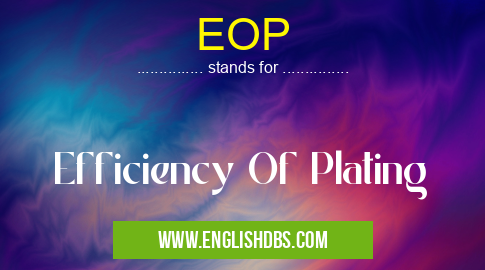What does EOP mean in BIOLOGY
Efficiency Of Plating (EOP), also known as Current Efficiency, is a critical parameter in the field of electroplating. It represents the percentage of the total electrical current passed through an electroplating bath that is actually used to deposit the desired metal on the cathode (or workpiece).

EOP meaning in Biology in Academic & Science
EOP mostly used in an acronym Biology in Category Academic & Science that means Efficiency Of Plating
Shorthand: EOP,
Full Form: Efficiency Of Plating
For more information of "Efficiency Of Plating", see the section below.
Understanding EOP
EOP is a measure of the effectiveness of the electroplating process. It indicates how much of the applied current is utilized for the desired electrodeposition reaction, rather than being lost due to side reactions or inefficiencies. A higher EOP generally translates to a more efficient and cost-effective plating process.
Factors Affecting EOP
Several factors influence the EOP of an electroplating bath, including:
- Current Density: High current densities can lead to reduced EOP due to the formation of hydrogen gas at the cathode.
- Concentration of Metal Ions: Low metal ion concentrations can result in low EOP as there are fewer ions available for deposition.
- Temperature: Elevated temperatures can increase EOP by promoting diffusion and reducing ion polarization.
- pH: The pH of the bath can affect the availability of metal ions and the formation of complexes, which can impact EOP.
- Additives: Certain additives can enhance EOP by reducing hydrogen evolution or improving the deposition process.
Calculation of EOP
EOP is typically calculated using the following formula:
EOP = (Weight of Deposited Metal / Theoretical Weight of Deposited Metal) x 100%- Weight of Deposited Metal: Determined by weighing the workpiece before and after electroplating.
- Theoretical Weight of Deposited Metal: Calculated based on Faraday's law of electrolysis, considering the current passed, time, and atomic weight of the metal.
Essential Questions and Answers on Efficiency Of Plating in "SCIENCE»BIOLOGY"
What is Efficiency of Plating (EOP)?
EOP is a measure of how efficiently metal is deposited onto the cathode during electroplating. It is expressed as a percentage of the theoretical amount of metal that should be deposited based on the current passed through the solution.
How is EOP calculated?
EOP is calculated by dividing the actual weight of metal deposited by the theoretical weight of metal that should have been deposited, and multiplying by 100%.
What factors affect EOP?
Factors that affect EOP include:
- Current density
- Solution temperature
- pH of the solution
- Concentration of metal ions in the solution
- Presence of impurities in the solution
What is a good EOP?
A good EOP is typically between 80% and 95%.
Why is EOP important?
EOP is important because it affects the quality and thickness of the plated coating. A low EOP can result in a thin or uneven coating, while a high EOP can result in a thick or rough coating.
How can EOP be improved?
EOP can be improved by optimizing the electroplating process, including:
- Using a higher current density
- Increasing the solution temperature
- Adjusting the pH of the solution
- Increasing the concentration of metal ions in the solution
- Removing impurities from the solution
Final Words: EOP is a vital parameter in electroplating that measures the efficiency of the process. By optimizing EOP, manufacturers can enhance the quality and consistency of plated products while minimizing operating costs. Through careful consideration of factors such as current density, metal ion concentration, and bath conditions, it is possible to achieve high EOP values and maximize the efficiency of electroplating operations.
EOP also stands for: |
|
| All stands for EOP |
